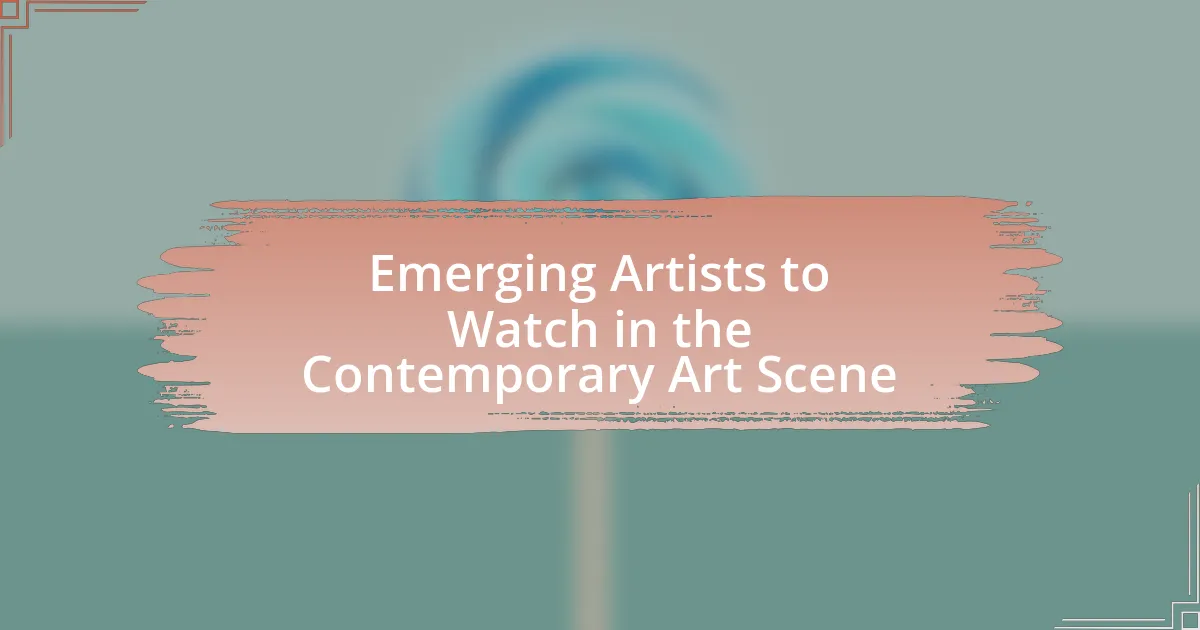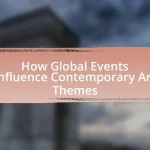The article focuses on emerging artists in the contemporary art scene, highlighting figures such as Jordan Casteel and Amoako Boafo, who are gaining recognition for their innovative approaches to portraiture. It defines emerging artists as those in the early stages of their careers, characterized by originality and potential for growth, and contrasts them with established artists. The article discusses the importance of monitoring emerging talent due to their influence on contemporary art trends and the art market, as well as the challenges they face, including financial constraints and limited visibility. Additionally, it outlines effective ways for collectors and art enthusiasts to support these artists, emphasizing the role of mentorship, networking, and online platforms in fostering their success.
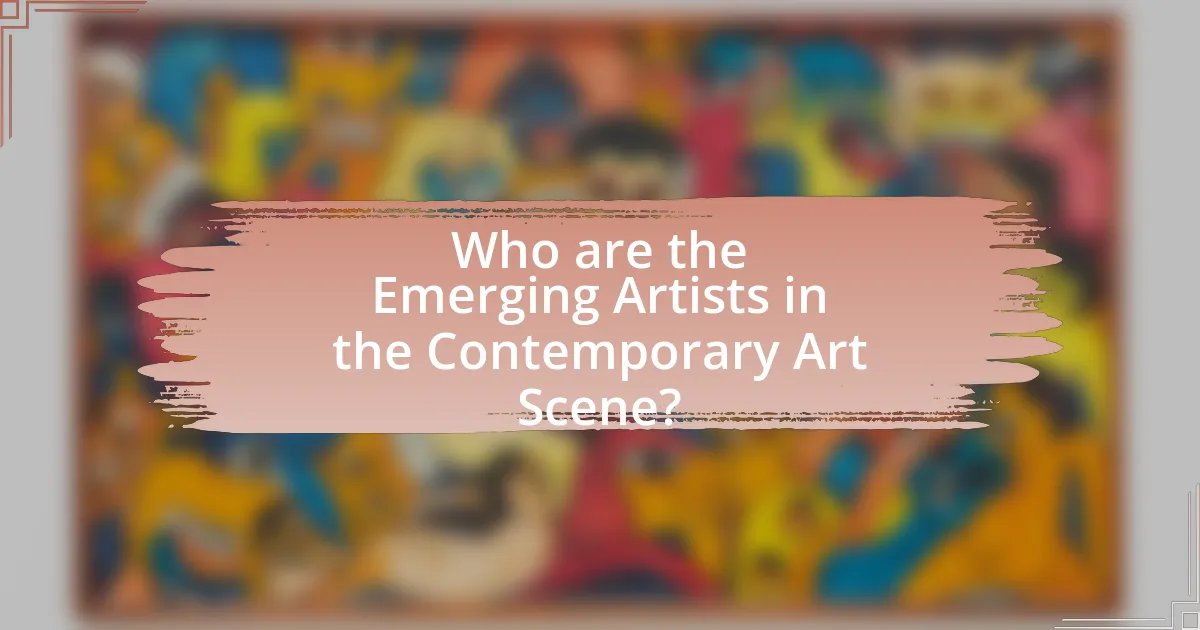
Who are the Emerging Artists in the Contemporary Art Scene?
Emerging artists in the contemporary art scene include figures such as Jordan Casteel, who is known for her vibrant portraits that explore themes of identity and community, and Amoako Boafo, recognized for his unique approach to portraiture using finger painting techniques. These artists have gained significant attention in recent exhibitions and art fairs, showcasing their work in prestigious venues like the Venice Biennale and Art Basel. Their innovative styles and thematic explorations reflect current societal issues, making them pivotal voices in contemporary art.
What defines an emerging artist in contemporary art?
An emerging artist in contemporary art is defined as an individual who is in the early stages of their artistic career, typically recognized for their innovative approach and potential for growth. These artists often have limited exhibition history and are gaining attention from galleries, critics, and collectors. The term “emerging” indicates that they are not yet established but show promise through unique styles, concepts, or techniques that resonate within the current art landscape. Emerging artists frequently participate in group exhibitions and art fairs, which serve as platforms for visibility and networking, further validating their status in the art community.
How do emerging artists differ from established artists?
Emerging artists differ from established artists primarily in their level of recognition and experience within the art world. Emerging artists are typically in the early stages of their careers, often seeking to build their portfolios and gain visibility, while established artists have a proven track record, a significant body of work, and often a loyal following. For instance, established artists may have exhibited in major galleries and museums, received prestigious awards, and have their works included in significant collections, whereas emerging artists are often still working towards these milestones. This distinction is crucial in understanding the dynamics of the contemporary art scene, where emerging artists are frequently identified for their innovative approaches and fresh perspectives, contrasting with the more traditional styles and established reputations of their counterparts.
What criteria are used to identify emerging artists?
Emerging artists are identified based on criteria such as originality, innovation, and potential for growth in their artistic practice. Originality refers to the uniqueness of their work and the ability to present new ideas or perspectives. Innovation involves the use of new techniques, materials, or concepts that challenge traditional norms. Additionally, potential for growth is assessed through their engagement with the art community, participation in exhibitions, and the ability to attract attention from critics and collectors. These criteria are supported by industry observations, such as the increasing recognition of artists who have gained visibility through social media platforms and art fairs, indicating their rising influence in the contemporary art scene.
Why is it important to watch emerging artists?
Watching emerging artists is important because they often bring fresh perspectives and innovative ideas to the art world. Emerging artists challenge established norms and contribute to the evolution of contemporary art, making their work vital for understanding current cultural trends. For instance, many renowned artists today, such as Banksy and Yayoi Kusama, began as emerging talents whose unique styles and concepts reshaped the art landscape. Engaging with their work can provide insights into future directions in art and foster a more diverse and inclusive artistic community.
What impact do emerging artists have on the art market?
Emerging artists significantly influence the art market by introducing fresh perspectives and innovative techniques that challenge established norms. Their work often attracts attention from collectors and galleries, leading to increased demand and higher prices for contemporary art. For instance, a report by Art Basel and UBS in 2021 indicated that the market for contemporary art, particularly from emerging artists, grew by 30% in the previous year, highlighting their role in driving market trends. Additionally, emerging artists often engage with social issues and new media, which resonate with younger audiences, further expanding the market’s reach and diversity.
How do emerging artists influence contemporary art trends?
Emerging artists significantly influence contemporary art trends by introducing innovative techniques and fresh perspectives that challenge established norms. Their unique approaches often reflect current social, political, and technological contexts, resonating with audiences and prompting shifts in artistic discourse. For instance, the rise of digital art and social media platforms has allowed emerging artists to reach wider audiences, fostering new forms of collaboration and interaction. This has led to the incorporation of multimedia elements and participatory practices in contemporary art, as seen in the works of artists like KAWS and Takashi Murakami, who blend traditional techniques with modern themes. Such contributions not only diversify the art landscape but also inspire established artists to adapt and evolve their practices, thereby shaping the trajectory of contemporary art.
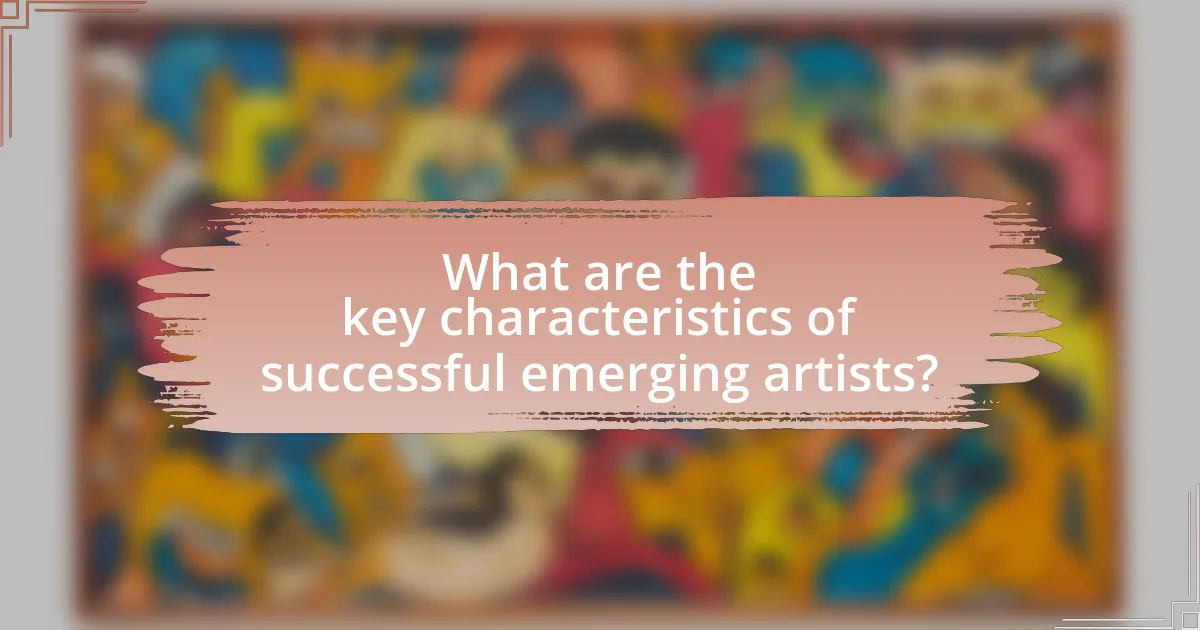
What are the key characteristics of successful emerging artists?
Successful emerging artists typically exhibit creativity, resilience, and a strong personal vision. Creativity allows them to produce unique and innovative works that stand out in a competitive market. Resilience helps them navigate challenges such as rejection and criticism, which are common in the art world. A strong personal vision enables them to develop a distinctive style and thematic focus, making their work more recognizable and impactful. These characteristics are essential for building a sustainable career and gaining recognition in the contemporary art scene.
How do emerging artists develop their unique styles?
Emerging artists develop their unique styles through a combination of experimentation, personal experiences, and influences from various art movements. They often explore different mediums and techniques, allowing them to discover what resonates with their artistic vision. For instance, many artists draw inspiration from their cultural backgrounds, social issues, or personal narratives, which shapes their creative expression. Additionally, exposure to diverse artistic practices and collaboration with other artists can further refine their style. Research indicates that artists who actively engage in art communities and seek feedback tend to evolve their styles more rapidly, as they incorporate new ideas and perspectives into their work.
What role does experimentation play in their artistic process?
Experimentation is central to the artistic process of emerging artists in the contemporary art scene, as it allows them to explore new techniques, materials, and concepts. This approach fosters innovation and personal expression, enabling artists to push boundaries and challenge traditional norms. For instance, many contemporary artists utilize mixed media or digital tools to create unique works that reflect their individual perspectives and societal issues. This emphasis on experimentation is supported by the fact that numerous successful contemporary artists, such as Takashi Murakami and Yayoi Kusama, have gained recognition for their willingness to experiment, leading to groundbreaking contributions to the art world.
How do emerging artists incorporate cultural influences into their work?
Emerging artists incorporate cultural influences into their work by drawing on their personal backgrounds, traditions, and societal contexts. They often blend elements from their heritage, such as motifs, techniques, and narratives, to create unique expressions that resonate with their identity. For instance, artists from diverse cultural backgrounds may utilize traditional patterns or storytelling methods, integrating them with contemporary themes to address current social issues. This approach not only honors their roots but also engages a broader audience by fostering cross-cultural dialogue.
What challenges do emerging artists face in the contemporary art scene?
Emerging artists face significant challenges in the contemporary art scene, primarily including limited access to funding, exposure, and professional networks. These artists often struggle to secure financial support, as traditional funding sources like grants and sponsorships are highly competitive and favor established artists. Additionally, emerging artists frequently lack visibility in galleries and exhibitions, making it difficult for them to reach potential buyers and audiences. According to a 2021 report by the National Endowment for the Arts, only 10% of artists receive funding for their projects, highlighting the financial barriers they encounter. Furthermore, the art market is dominated by established names, which can overshadow new talent, creating an environment where emerging artists find it challenging to gain recognition and build a sustainable career.
How do financial constraints affect their artistic development?
Financial constraints significantly hinder artistic development by limiting access to materials, education, and opportunities for exposure. Emerging artists often struggle to afford high-quality supplies and tools necessary for their craft, which can stifle creativity and experimentation. Additionally, financial limitations restrict participation in workshops, classes, and mentorship programs that are crucial for skill enhancement. According to a study by the National Endowment for the Arts, artists with limited financial resources are less likely to exhibit their work, resulting in reduced visibility and networking opportunities essential for career advancement. This lack of exposure can lead to stagnation in their artistic growth and professional trajectory.
What barriers exist in gaining visibility and recognition?
Barriers to gaining visibility and recognition for emerging artists include limited access to established networks, financial constraints, and market saturation. Emerging artists often struggle to connect with galleries, curators, and collectors who can elevate their profiles, as these networks are typically dominated by more established figures. Financial constraints hinder their ability to produce and promote their work effectively, as many lack the resources for marketing, studio space, and materials. Additionally, the contemporary art market is saturated with numerous artists vying for attention, making it challenging for newcomers to stand out. According to a report by Art Basel and UBS, the competition in the art market has intensified, with over 300,000 artists exhibiting globally, further complicating visibility for those just starting.
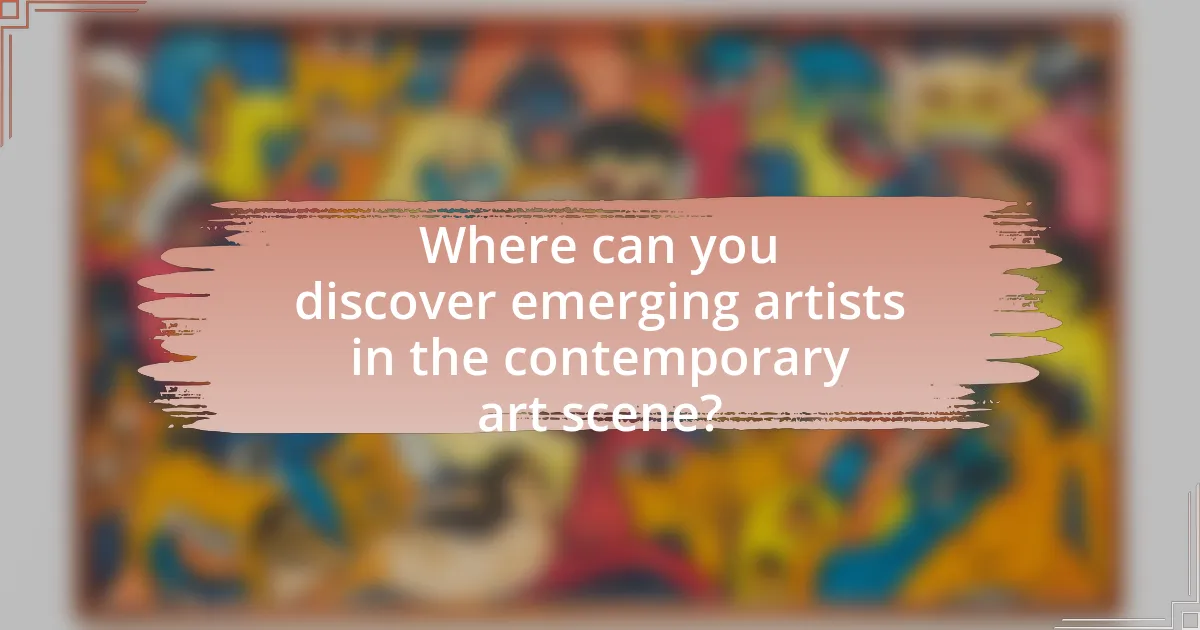
Where can you discover emerging artists in the contemporary art scene?
You can discover emerging artists in the contemporary art scene at art fairs, galleries, and online platforms dedicated to showcasing new talent. Art fairs such as Frieze and Art Basel often feature sections specifically for emerging artists, providing them with visibility among collectors and curators. Additionally, many contemporary art galleries focus on promoting new artists, offering exhibitions that highlight their work. Online platforms like Artsy and Saatchi Art also curate collections of emerging artists, making it easier for audiences to explore and purchase their art. These venues collectively contribute to the visibility and recognition of new talent in the contemporary art landscape.
What platforms are best for showcasing emerging artists?
Social media platforms like Instagram and TikTok are best for showcasing emerging artists. These platforms allow artists to share their work visually and engage with a global audience, facilitating direct interaction and feedback. According to a 2021 survey by Artfinder, 70% of artists reported that social media significantly increased their visibility and sales. Additionally, online galleries such as Saatchi Art and Artsy provide dedicated spaces for emerging artists to exhibit their work, often reaching collectors and art enthusiasts who are specifically looking for new talent.
How do social media and online galleries contribute to their visibility?
Social media and online galleries significantly enhance the visibility of emerging artists by providing platforms for widespread exposure and engagement. These digital spaces allow artists to showcase their work to a global audience, bypassing traditional barriers such as geographic limitations and gallery representation. For instance, platforms like Instagram and Pinterest enable artists to share their portfolios, connect with potential buyers, and engage with art communities, leading to increased recognition and opportunities. According to a 2021 survey by Art Basel and UBS, 63% of collectors reported discovering new artists through social media, highlighting its critical role in the contemporary art scene. Online galleries further amplify this effect by curating collections that can reach diverse audiences, thus facilitating sales and collaborations that might not occur in conventional settings.
What role do art fairs and exhibitions play in promoting emerging talent?
Art fairs and exhibitions serve as crucial platforms for promoting emerging talent by providing visibility and networking opportunities. These events allow new artists to showcase their work to a diverse audience, including collectors, curators, and art enthusiasts, which can lead to sales and representation. For instance, the Armory Show in New York has historically launched the careers of numerous artists by connecting them with influential figures in the art world. Additionally, participation in such events often results in media coverage, further enhancing the artists’ profiles and facilitating future opportunities.
How can collectors and art enthusiasts support emerging artists?
Collectors and art enthusiasts can support emerging artists by purchasing their works, which provides financial stability and recognition. When collectors invest in pieces from new artists, they not only validate the artists’ efforts but also help them gain visibility in the competitive art market. According to a report by Art Basel and UBS, 70% of collectors believe that buying art from emerging artists is essential for fostering new talent. Additionally, collectors can promote emerging artists through social media, exhibitions, and word-of-mouth, further enhancing their reach and opportunities for success.
What are effective ways to engage with and purchase from emerging artists?
Effective ways to engage with and purchase from emerging artists include attending art fairs, visiting local galleries, and utilizing online platforms dedicated to showcasing new talent. Art fairs provide direct access to a variety of emerging artists, allowing collectors to interact with them and understand their work firsthand. Local galleries often feature exhibitions focused on new artists, creating opportunities for personal engagement and purchase. Online platforms, such as Artsy and Saatchi Art, facilitate the discovery and acquisition of artworks from emerging artists globally, often providing detailed artist profiles and purchasing options. These methods are validated by the increasing trend of art buyers seeking unique pieces from lesser-known creators, as reported by the Hiscox Online Art Trade Report, which highlights a growing market for emerging artists.
How can mentorship and networking benefit emerging artists?
Mentorship and networking significantly benefit emerging artists by providing guidance, opportunities, and connections within the art community. Mentorship offers emerging artists access to experienced professionals who can share valuable insights, techniques, and industry knowledge, which can enhance their artistic development and career trajectory. Networking facilitates relationships with peers, galleries, and potential buyers, increasing visibility and opportunities for collaboration and exhibition. According to a study published in the Journal of Arts Management, Law, and Society, artists who engage in networking are 50% more likely to secure exhibitions and sales compared to those who do not. This evidence underscores the importance of mentorship and networking in fostering the success of emerging artists in the contemporary art scene.
What are the best practices for following and supporting emerging artists?
The best practices for following and supporting emerging artists include actively engaging with their work, sharing their art on social media, attending their exhibitions, and providing constructive feedback. Engaging with their work fosters a community around the artist, while sharing their art increases visibility and reach. Attending exhibitions allows for direct support and connection, and constructive feedback can help artists grow and refine their craft. According to a study by the National Endowment for the Arts, community engagement significantly impacts an artist’s career trajectory, highlighting the importance of active support from followers.
